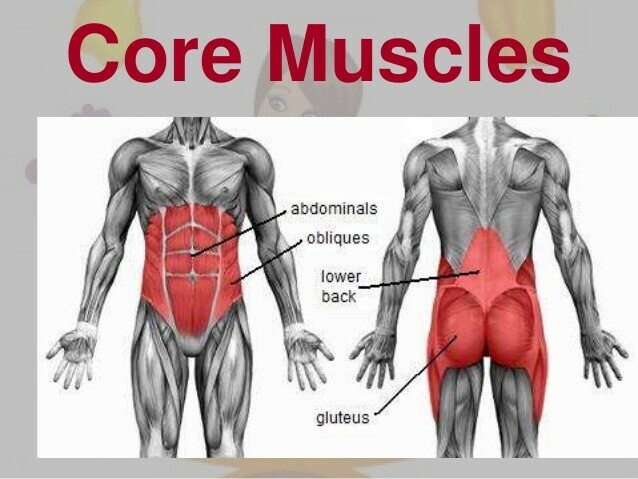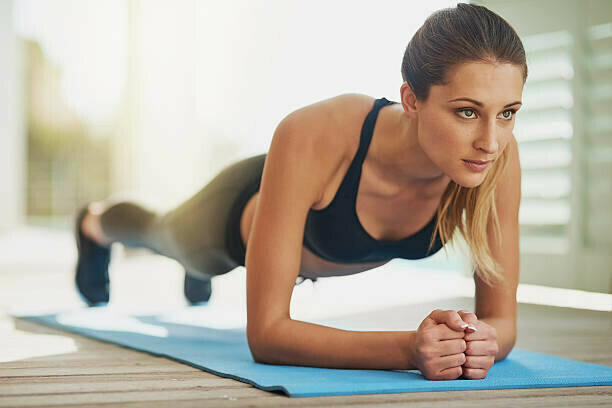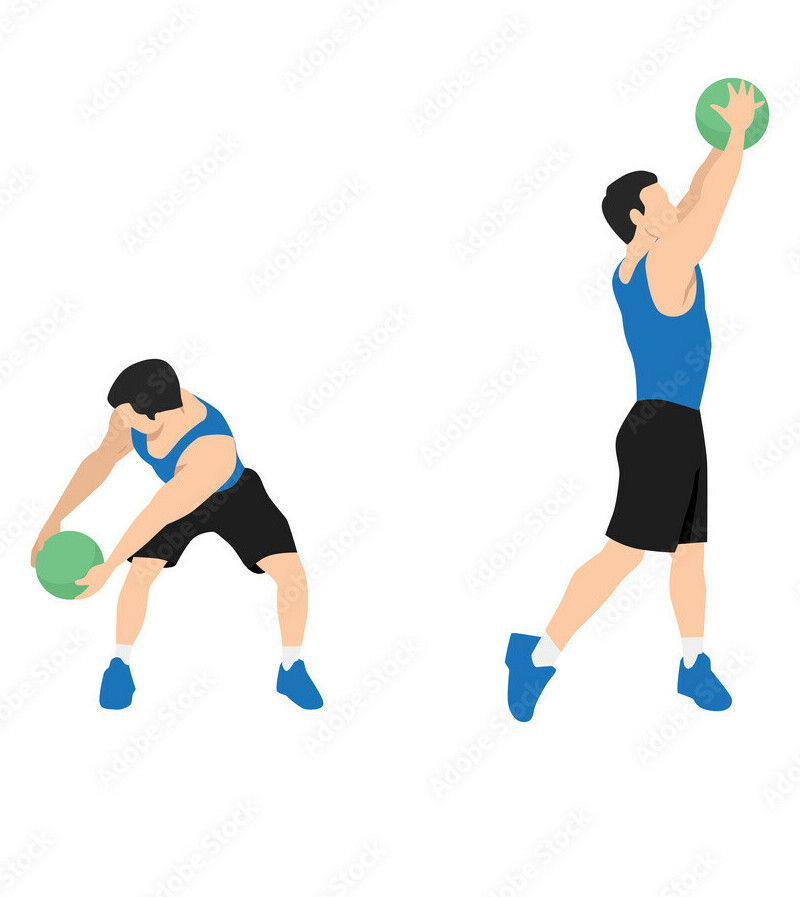WHY DO WE EXERCISE OUR CORE?
Our cores are the central parts of our bodies – our pelvis, hips, lower back and stomach. These are the muscles around our trunks, including the pelvis.
The Mayo Clinic tells us that our core muscles will make it easier to swing a golf club, reach a top shelf or bend down to tie our shoes. Strong core muscles benefit athletes and help to prevent muscle injuries and falls as we age. They help to improve our posture.
Here are the core muscles:

My core routine does not include floor sit-ups or crunches. This is because I have lower back pain. My preference is to stay away from floor abdominal exercises, with the exception of the plank. But I have consistently done floor sit-ups and crunches in the past, when I was younger. I had used a crunch device to support my back. Floor crunches and sit-ups work! But my routine now excludes them. Instead, I do a seated crunch, to be described later.
MY PERSONAL ROUTINE
I do a workout every morning before breakfast. This includes:
- Physical therapy – for my fingers and right rotator cuff
- Core
- Upper torso – back, chest, biceps, triceps – alternated daily with
- Cardio – a mile or two on my treadmill
If I feel especially energetic, I may include cardio on my upper torso days. But it is usually one or the other. Also, I may at times hold off on cardio until the afternoon. I never do torso exercise on consecutive days.
My core routine includes planks, standing medicine ball exercises, seated crunches and isometric pelvic muscle holds.
PLANKS. These are isometric bodyweight exercises that require holding a static position as we resist tension and gravity. We are supporting our bodies by our forearms and toes. See below.
 Holding a plank demands that several muscle groups work in harmony – our front abdominals, our obliques, our spine muscles, our glutes and legs. Even our chests, necks, arms and shoulders are involved.
Holding a plank demands that several muscle groups work in harmony – our front abdominals, our obliques, our spine muscles, our glutes and legs. Even our chests, necks, arms and shoulders are involved.
There is some debate on how long we should hold a plank. It becomes an ego contest with some. Many experts recommend no more than a minute or two. It is interesting to me that Carlos Alcaraz (young tennis star with incredible abs) does only 30 second or one minute planks. See my prior post – How does Carlos Alcaraz stay in shape?
Here is a video on planks for beginners, showing several different versions.
STANDING MEDICINE BALL EXERCISES. In order to avoid floor crunches or sit-ups, I decided to purchase a smaller medicine ball and stress my core standing up. It turns out that this works better for me than the crunches, even when I had no back pain.
I do woodchops, 40 reps, from side to side, with a 6 lb. medicine ball. See below. The six pound weight is surprisingly effective in thoroughly working my obliques as I pivot from one side to the other. After 20 reps, I change to a more vertical chop, to engage my front abdominal muscles for 20 of those additional reps.

After these 40 reps, I rest for a while and then begin with another 40 reps with an additional version. I stand straight and do not pivot. I move the medicine ball from my right side to my left, resisting to make the movement more effective. I also gradually raise the position of my arms from knees to shoulders.
Here is a short video on the correct form for the medicine ball woodchop.
SEATED CRUNCHES. This is an exercise that I created so that I could sit down as I worked. It requires the Bullworker Steel Bow in my version. I sit on a chair (not a soft one) and press down with 20 reps to the right, 20 to the left and 30 to the center. I don’t have a picture of my version, but the one below is somewhat similar, though he has no chair. Also, he is using the Bow Classic.
In my version, my feet are on the floor and I press down to different sides of the chair. I do slow crunches and hold isometrically after each set of reps. This is highly effective and easy on the joints.

Here is a “killer core workout” with Bullworker tools. You can see how this kind of crunch is effective. (I like Bullworkers since I can experiment and create exercises that suit my needs).
ISOMETRIC PELVIC MUSCLE HOLDS
The pelvic floor muscles are located between the tailbone and the pubic bone. I exercise these muscles by squeeze and release, or isometric, reps. This is another bit of training that I created. I don’t know of any popular training method for these muscles, except maybe Kegels. I recently discussed this with my urologist and he encouraged me to keep doing them.
I do these lying down on a sofa. First, I do 30 reps of 5 second holds. There is no reason to hold our breath when doing these. Normal conversation is no problem. We can even do them while standing up or walking.
After the first set of 30 reps, I do a second set of 10 reps, but with timed 30 second isometric holds. I am confident that this is of benefit to that very private part of my body. This brings my core routine to a close.
AMAZON
I am both an Amazon customer and associate. As a customer, I enjoy the fast delivery and wide selection of goods. As an associate, I use their links within my articles when I see relevance. If the links result in sales conversions, I may earn commissions. This is affiliate marketing. For complete information on affiliate marketing, see my upper menu “Become an affiliate marketer”.
The links will show complete information, pictures, prices, reviews and suggestions for other similar or supplementary items. Here are a couple of links:
This is the medicine ball I use. I like the 6 lb. version, which gives me plenty of resistance for the high reps I do. It is easily stored when not in use.
This is the crunch device I once used. It protected my back by giving me support on floor crunches. I still have it, but have decided to stop doing floor crunches, though it worked well.
BULLWORKER
Bullworker products are important to all of my routines, including core training. These tools are of exceptionally high quality and they are long lasting. I use the Steel Bow for chest training as well as the chair crunches described above.
I also have the Bow Classic, primarily for back training. See it in the Bullworker video shown above.
My Bullworker link is at the side of my website. Click on the red link for full information on their products.
FINAL THOUGHTS
Core training is essential to a full body workout. For me, the core is the muscle group that I prioritize, though this has not always been the case. (I learn as I age).
Core training:
- Stabilizes the lower back
- Builds flexibility
- Supports better posture
- Improves balance
- Helps to prevent or reduce pain
- Eases our routine every day movements
- Help to reduce lower body injuries
For purposes of vanity alone, core routines will reduce our waist lines, especially when accompanied by cardio exercise and healthy nutrition.
Please leave me any comments or questions in the “Comments” section below. Or email me, richard@myworkoutathome.com.
Let’s never ignore our core muscles!
Thanks for this good explanation of your core routine at home. I know this is very important, especially as I get older. I have done planks in the past and need to get back to it. I had worked up to a 90 second plank and I was happy with that.
I have also done lunge holds and the wall sit (I don’t know if that is the correct name for it) with my back against the wall and my thighs parallel to the floor as if sitting in a chair. That’s a rough one, but I guess that isn’t a core exercise as much as it is a leg exercise.
Your post is encouraging me to get back to it!
Thanks, Scott, for expanding my post with your personal experience. I have never tried a wall sit, but have heard that they are effective isometric forms of training. Our encouragement is mutual!